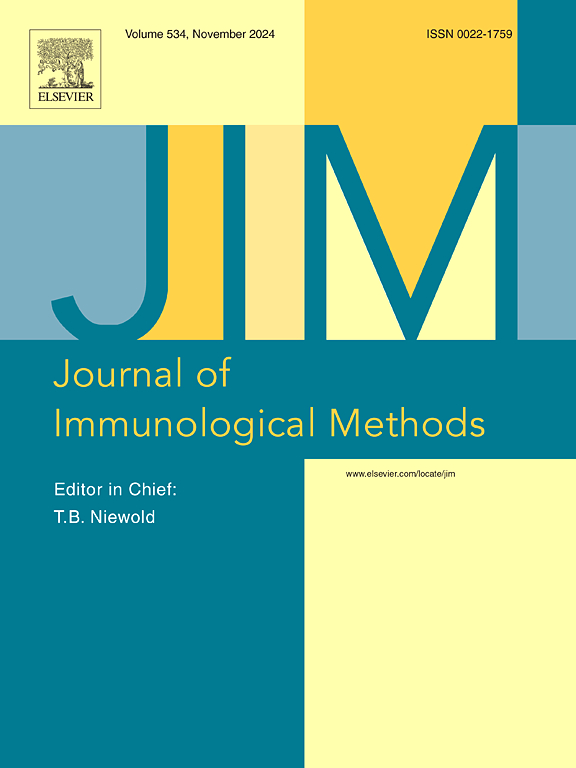Development and validation of dengue virus envelope protein domain III IgG antibody enzyme-linked immunosorbent assay
IF 1.6
4区 医学
Q4 BIOCHEMICAL RESEARCH METHODS
引用次数: 0
Abstract
Introduction
The global incidence of Dengue virus (DENV) infections has significantly increased in recent decades, becoming a public health emergency of global concern. Diagnostic tools for DENV infection include detection of the virus, viral RNA, or viral antigens, which are usually cumbersome or require sophisticated medical facilities and trained personnel. Serological tests are the most widely used methods to detect dengue infection due to low cost and operational simplicity. The detection of antibodies (IgM and IgG) in the blood of an infected individual is an indirect method of diagnosing DENV and IgG can be used as long-term detection. The aim of this work was to develop and validate an enzyme-linked immunosorbent assay (ELISA) for the detection of anti-DENV IgG antibodies, and to determine its usefulness in the diagnosis and seroepidemiological survey of DENV.
Materials and methods
The production of the antigen was carried out using the tetravalent DENV E protein-based provided by Trebe Biotech. The recombinant baculovirus was obtained using the Bac to Bac® baculovirus expression system. The recombinant tetravalent dengue antigen was expressed in insect larvae, purified by IMAC and identified by SDS-PAGE and western blot analysis. The system used in this work has the advantage of using insect pests as biofactories. Recombinant protein production is high-yield and production times are short. Furthermore, it has no product size limit and is highly flexible to sequence changes or the emergence of new serotypes. An indirect ELISA was developed using purified tetravalent DENV antigen immobilized on polystyrene microplates; human sera samples from individuals with no history of DENV infection (n = 22) and human sera samples from individuals with clinical history and diagnosed of DENV infection (n = 23) were then incubated. Immune complexes were revealed with anti-human IgG-Horseradish Peroxidase. Results were calculated as specific absorbance and expressed as standard deviation scores: SDs. In order to establish DENV-IgG seroprevalence, the developed ELISA was applied to analyze samples from blood donor centers from different geographic regions of the country (n = 504) and normal human sera (n = 17).
Results
The efficiently produced recombinant dengue antigen was used for the development and validation of a high sensitivity (91.30 %) and specificity (90.91 %) indirect ELISA for the detection of anti-DENV IgG antibodies. The ROC curves demonstrated that this method had high accuracy to distinguish between samples from normal control individuals and patients with DENV (AUC = 0.9901); the cut-off value was established at 2 SDs. In the assessment of seroprevalence levels of anti-DENV antibodies, 33 out of 504 analyzed samples (6.55 %) tested positive using our developed ELISA.
Conclusions
This technique is rapid, cost-effective, and easy to use, making it suitable for low or medium complexity laboratories, especially when compared to molecular or culture-based testing. This confirms that the assay is both robust and reliable for diagnosing DENV infection, making it suitable for resource-limited areas.
登革病毒包膜蛋白结构域III IgG抗体酶联免疫吸附试验的建立与验证。
近几十年来,登革热病毒(DENV)感染的全球发病率显著增加,成为全球关注的突发公共卫生事件。DENV感染的诊断工具包括检测病毒、病毒RNA或病毒抗原,这些工具通常很麻烦,或者需要复杂的医疗设施和训练有素的人员。由于成本低和操作简单,血清学检测是检测登革热感染最广泛使用的方法。检测感染者血液中的抗体(IgM和IgG)是诊断DENV的间接方法,IgG可作为长期检测。本研究的目的是建立和验证一种酶联免疫吸附试验(ELISA),用于检测DENV抗体IgG抗体,并确定其在DENV诊断和血清流行病学调查中的实用性。材料和方法:抗原的制备采用Trebe Biotech提供的四价DENV E蛋白为基础。利用Bac to Bac®杆状病毒表达系统获得重组杆状病毒。重组四价登革热抗原在昆虫幼虫中表达,经IMAC纯化,SDS-PAGE和western blot分析鉴定。本研究采用的系统具有利用害虫作为生物工厂的优点。重组蛋白产量高,生产时间短。此外,它没有产品大小限制,对序列变化或新血清型的出现具有高度灵活性。将纯化的DENV四价抗原固定在聚苯乙烯微孔板上,建立了间接ELISA法;无DENV感染史的人血清样本( = 22)和有DENV感染临床史的人血清样本( = 23)进行孵育。发现抗人igg -辣根过氧化物酶免疫复合物。结果以比吸光度计算,并以标准差分数(SDs)表示。为了确定DENV-IgG的血清阳性率,应用开发的酶联免疫吸附试验(ELISA)分析了来自全国不同地理区域献血者中心的样本(n = 504)和正常人血清(n = 17)。结果:利用高效制备的重组登革抗原,建立了高灵敏度(91.30 %)和高特异性(90.91 %)的间接ELISA法检测登革病毒IgG抗体。ROC曲线表明,该方法对正常对照和DENV患者样本的区分准确度较高(AUC = 0.9901);截止值为2个SDs。在评估抗denv抗体的血清阳性率水平时,504个分析样本中有33个(6.55 %)使用我们开发的ELISA检测为阳性。结论:该技术快速,成本效益高,易于使用,适用于低或中等复杂程度的实验室,特别是与分子或基于培养的检测相比。这证实了该检测方法在诊断DENV感染方面既稳健又可靠,使其适用于资源有限的地区。
本文章由计算机程序翻译,如有差异,请以英文原文为准。
求助全文
约1分钟内获得全文
求助全文
来源期刊
CiteScore
4.10
自引率
0.00%
发文量
120
审稿时长
3 months
期刊介绍:
The Journal of Immunological Methods is devoted to covering techniques for: (1) Quantitating and detecting antibodies and/or antigens. (2) Purifying immunoglobulins, lymphokines and other molecules of the immune system. (3) Isolating antigens and other substances important in immunological processes. (4) Labelling antigens and antibodies. (5) Localizing antigens and/or antibodies in tissues and cells. (6) Detecting, and fractionating immunocompetent cells. (7) Assaying for cellular immunity. (8) Documenting cell-cell interactions. (9) Initiating immunity and unresponsiveness. (10) Transplanting tissues. (11) Studying items closely related to immunity such as complement, reticuloendothelial system and others. (12) Molecular techniques for studying immune cells and their receptors. (13) Imaging of the immune system. (14) Methods for production or their fragments in eukaryotic and prokaryotic cells.
In addition the journal will publish articles on novel methods for analysing the organization, structure and expression of genes for immunologically important molecules such as immunoglobulins, T cell receptors and accessory molecules involved in antigen recognition, processing and presentation. Submitted full length manuscripts should describe new methods of broad applicability to immunology and not simply the application of an established method to a particular substance - although papers describing such applications may be considered for publication as a short Technical Note. Review articles will also be published by the Journal of Immunological Methods. In general these manuscripts are by solicitation however anyone interested in submitting a review can contact the Reviews Editor and provide an outline of the proposed review.

 求助内容:
求助内容: 应助结果提醒方式:
应助结果提醒方式:


